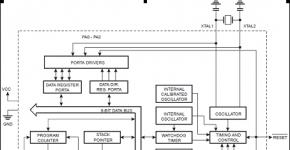Fallen foliage. What to do with fall foliage
Autumn is the most colorful time of the year: trees sparkle with all colors and are cast in gold. Each of us tries to enjoy in the garden during these remaining warm days. And everything would be fine if it were not for the leaves, which after the first cold nights massively fall from the trees, covering the ground with a thick multi-colored carpet. Many gardeners are desperately wondering: “What to do with all this multicolor? Leave on the ground or remove? ”Do not panic: there are many ways to rationally use fallen leaves, even in a small garden.
Leaf mulch is good for plants
Fallen is a good mulch for all plants that naturally grow in the forest or at the edge of the forest. Having a deciduous layer of mulch, they bloom in full force, as this corresponds to their living conditions in their natural habitat. During the new garden season, the leaves decompose and enrich the earth with humus. By the way, such “natives of the forest”, like raspberries and strawberries, also respond positively to deciduous cover in the basal zone.
Composting fallen leaves - how does this happen?
To get special, you need to mix as many different types of leaves as possible. How quickly the leaves will decompose depends on the type of tree. The leaves of linden, alder, beech, ash, birch and hazel quickly decompose. If you mix the branches and sprinkle several shovels of the finished compost, you can prevent sticking of leaves. To lay the compost heap dry and wet leaves of different tree species are mixed. Pre-chopping leaves contributes to better composting.
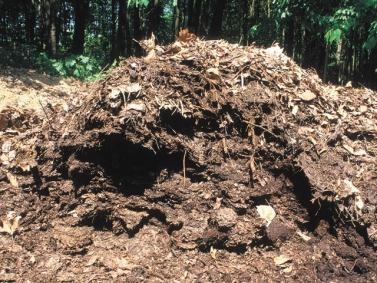
For speedy decomposition, do not let the leaves clump, loosen them to saturate with air
Hardly decaying foliage
The decomposition of foliage with a high content of tannins or coarse leaves, for example, from chestnut, poplar, walnut or plane tree, can be accelerated by mixing them with wood chips or mowed grass. Fresh herbs contain a lot of nitrogen, which contributes to the good reproduction of microorganisms and the rapid decomposition of autumn foliage, poor in nutrients. If the lawn mowing season is over, take a regular compost ripening accelerator. The straw section provides good aeration of the mixture, which also contributes to the acceleration of composting. In conclusion, the leaves are covered with a layer of garden soil and constantly maintain humidity. In the spring, compost is shoveling, shifting from one section to another and by autumn it will be completely ready.

Oak leaves decompose slowly
Leaf humus is an effective means of improving soil
It usually takes a year to ripen leaf humus. Although humus does not contain nutrients, it is excellent for improving soil quality for all plants that prefer a loose, humus-rich base. In addition, floribudna roses can be sprinkled with leaf compost to protect them in the winter from damage caused by frost.
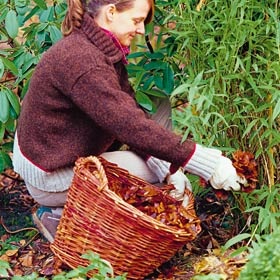
Oak Leaves for Rhododendrons
If the leaves of hornbeam and linden decompose quite quickly, then in oak, because of the high content of tannins, this process takes more than one year. Therefore, fresh fallen oak foliage is best used for mulching rhododendrons. During decomposition, the leaves secrete acid, which helps to reduce the pH in the soil - these are ideal conditions for rhododendrons and other garden crops that cannot tolerate too high a pH level of the soil.
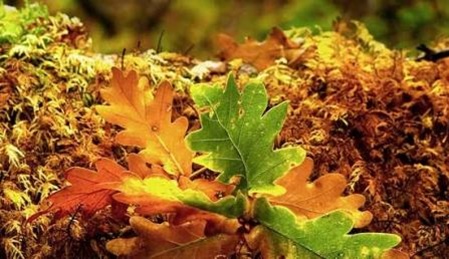
Wire mesh leaf container
Flower beds are covered with fallen leaves, and all containers for compost are filled to the top? Then buy a few meters of wire mesh in a construction supermarket and connect its ends with floristic wire so that you get a voluminous basket.
![]()
It can be put in the garden and used as a container for storing leaves. The layer of leaves, decomposing and under its weight, will gradually settle, therefore, despite the fact that you have filled the basket to the top, after a while a lot of space will be freed up for new leaves.
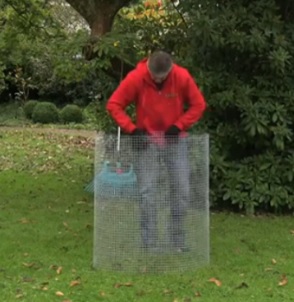
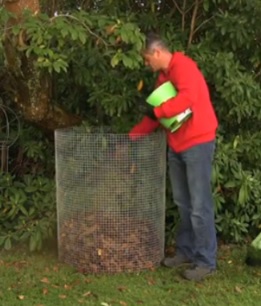
The better to clean the fallen leaves
While the romantics, watching the whirling of autumn leaves, languidly sigh and indulge in dreams, practical gardeners take up brooms and go to restore order in their area. But technological progress does not stand still, and hand tools have been replaced by convenient leaf blowers. Despite all the advantages of modern equipment for harvesting autumn leaves, many environmental protection unions, such as the German Nature Conservation Union NABU, warn gardeners against the constant use of garden vacuum cleaners, which, above all, have a fatal effect on beneficial insects. According to the NABU Newsletter, the rate of air intake by the blower is up to 160 km per hour. And the subsequent chopping function is fatal for beneficial insects that were on fallen leaves and were chopped with them.
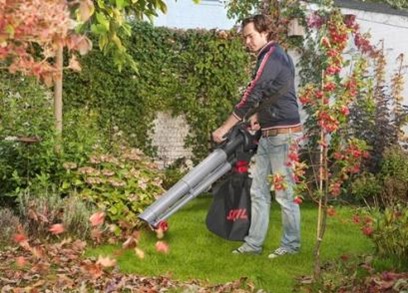
Not only bugs, spiders and wood lice, but also frogs and small hedgehogs can be drawn in and thrown out through the nozzle with a stream of air. According to studies by the Bavarian Conservation Union, many of these animals are of great environmental importance to the soil. The absence of small animals and foliage can lead to a depletion of edafon - a complex of soil-living organisms - and hinder the formation of humus. In addition, due to the complete elimination of foliage and plant debris, beneficial insects, hedgehogs and butterfly larvae lose their refuge, which is so necessary for them in the winter.

According to the Bavarian Conservation Union, certain problems are caused by the use of a garden blower for cleaning roads, garage entrances, and streets. During absorption, together with the leaves, small particles of dust rise in the air, which contain soot, as well as carcinogenic substances that cause cancer, which enter the atmosphere when the tires of cars are abraded and which we breathe.
Therefore, environmentalists advise, if possible, to abandon the use of garden vacuum cleaners and blowers and recommend collecting foliage "the old fashioned way" - a broom or rake. So, in flower beds, between shrubs, you can collect leaves using special fan rakes that do not damage neighboring plants, on terraces, paths and other flat surfaces, it is convenient to collect leaves with a broom. One of the main advantages of assembling leaves with “old-fashioned” hand tools is that they can be used in wet weather, which is not uncommon in autumn, which cannot be said about garden blowers that work with wet foliage absolutely ineffectively.
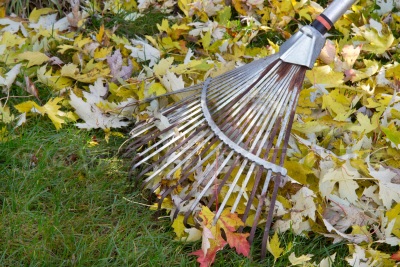
If you would like to use a garden vacuum cleaner or blower, environmentalists recommend choosing electric models that work much quieter than models with a gasoline engine. This will spare the nerves of your neighbors and the peace of your family.
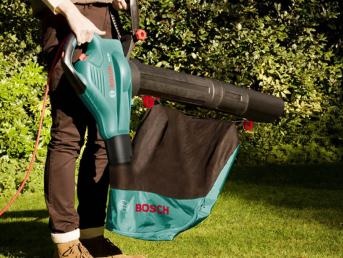
Expert Thomas Oberst from the German expert organization TÜV Süd, headquartered in Munich, advises you to pay attention to the size of the bag when buying a garden vacuum cleaner. It should be easy to install, have a large hole, so that it would be convenient for an amateur gardener to pour out the contents. The bag should be 40-45 liters. A small bag will have to be emptied more often, and too large - creates inconvenience during operation.
Translation: Lesya V.
specially for the internet portal
Garden Center "Your Garden"
Autumn leaf fall upsets summer residents with additional chores. Many do not know how to use this valuable raw material. Humus from leaves is an ideal remedy for a vegetable garden, flower garden and garden. Read about which leaves to collect, how to lay and apply the finished substrate.
Sheet earth
Overripe leaves are called leafy soil. This product is considered nutritious and easy for plant growth, indispensable in complex mixtures for garden, horticultural crops, and also highly appreciated by gardeners. It is added in the amount of 20-80% of the total amount of soil.It takes two years to produce high-quality sheet land, if you are satisfied with the rough structure, then you can use it in six months. A place for foliage is chosen in the depths of the garden, where no work is planned. The collected leaves are stacked in high piles, about a meter. The process of complete decay lasts a long time and requires hydration. To obtain uniformity and enhance rotting, it is advisable to shovel twice.
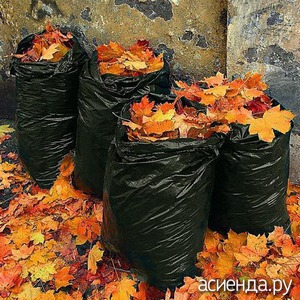
Experts do not recommend using a leaf of chestnut and oak to create such humus. Since the concentration of tannins slows down the decomposition. In the future, humus from these leaves negatively affects the condition of the roots and is unsuitable for garden plants. Also, you can not use leaves affected by fungal and other infections.
The benefits of leafy land
When deciduous humus is added to the soil, its structure improves and its nutritional composition increases. The earth, flavored with such a product, breathes well, promotes the supply of moisture to the roots, prevents the soil from drying out, protects plants from frost, and helps to survive drought.Unripe leaf humus is a valuable addition to compost, an ideal medium for earthworms. Transforming fallen leaves into fertilizer, the gardener gets rid of the need for removal and burning of foliage. Sheet earth - a natural acidifier, allows you to refuse to buy peat, bought to improve the composition of the soil.

Leaf bookmark
Foliage can be stored in different ways: metal mesh constructions are created, plastic containers are used. A completely simple way is with plastic bags sold for garden waste. The bag is densely packed with collected leaves, tied, several punctures are made on the surface.The main condition for production is the use of well-moistened foliage. If the weather is dry during the collection of raw materials, then at the time of laying it should be watered and the container / bag should be left open so that it can be further moistened by adding water. To accelerate decomposition, it is recommended to combine leaves with green grass / tops.
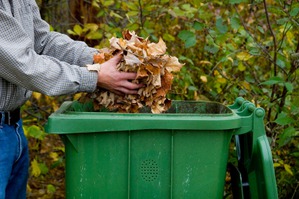
Container for leaf humus
An effective way to obtain hardwood humus are mesh designs. You will need a fine wire mesh, wooden bars or metal pipes, staples / wire, wire cutters, a hammer.The building is usually located under the trees or in a place where you can moisten, without harming neighboring plants. Capacity is created in the form of a cube. The size is maintained in the range of 50-70 cm, h - 120. The posts are deepened by about 30 cm. The net is attached to the first support with brackets or wire in 3-4 places, then rolled to the second post - fixed. And so it sequentially closes on the first support, forming a mesh box. The excess mesh is cut off with nippers; the protruding ends should be bent with a hammer to avoid injuries.
Using leaf humus
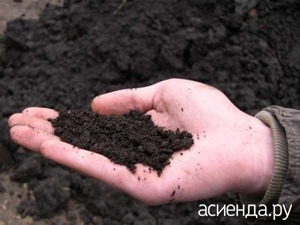
Young humus is obtained after 6-12 months. It has a rough structure with the remains of the skeleton / petioles of leaves. It is used as an additive for soil mixtures of open ground and container landings. The product is relevant for mulching, adding to garden compost, lawn repair.
Aged humus is prepared for about 2 years. It is a homogeneous, friable, dark color. Such a substrate is good for seed germination and seedling production. Together with fine-grained sand / loam, garden compost, leafy soil is ideal for growing indoor plants. In pure form, it is applied to hydrangeas, rhododendrons, azaleas, camellias, heathers, pyrises, and other acidophiles that prefer acidic soil.
Autumn-fall ... As the song says, the forest cooled down and dropped the leaves ... This time is truly colorful and mysterious. You go, and the leaves rustle under your feet. For janitors, leaf litter is a real problem, but for gardeners, on the contrary, a great way to improve soil quality. After all, from the fallen yellow, red, brown furniture, you can cook a very good humus for enriching the soil in the garden. Such a fertilizer gifted by nature itself has a harmonious combination of properties, therefore more and more summer residents prefer natural to chemical or artificial.
Leaf litter collection
Falling foliage: is it useful?
Many argue that humus from walnut foliage and other trees does not contain useful substances. But they are wrong. Such fertilizers contain sulfur, iron, phosphorus, nitrogen and other trace elements that are essential for soil and plants. In addition, leaf litter loosens the earth, retains moisture during hot weather and saturates the soil layer with oxygen. In addition, humus is a favorite habitat for earthworms, which provide invaluable assistance to gardeners.
Mother nature has thought through everything so subtly that a person is sometimes amazed. Solar energy is accumulated by the green crown. And in autumn, leaves falling from trees perfectly fertilize the soil. Many took note: once in the woods in the lap of nature, so to speak, everything grows without chemical additives and artificial fertilizers, why not use this principle for the benefit of your garden. Therefore, mulch from the leaves has become an indispensable helper in the garden and in the summer cottage.
The leaves of ash, cherry, walnut, oak and other trees give new life to soil-living organisms, which, in turn, gradually process the material that came to them. Such complex "connections" saturate the soil with useful elements, and harmful substances are destroyed into simple components. As a result of close-knit work, plants receive organic additives without harming the environment. 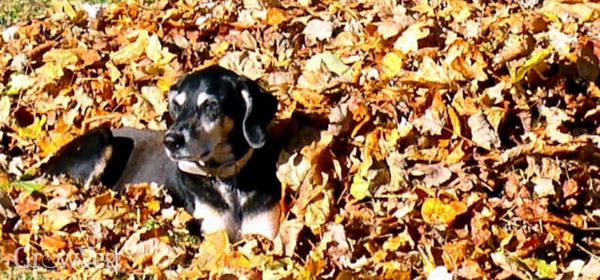 Autumn leaves - the future fertilizer
Autumn leaves - the future fertilizer
Long-term experience of gardeners proves that making fertilizer in the fall means getting an unsurpassed crop next year. All the advantages of natural humus are obvious:
- cost savings (useful for the family budget),
- soil nutrition (useful for plants, insects and small animals),
- preventing weeds and normalizing the temperature of the land cover at different times of the year (useful for crops).
Humus Recipes
There are several types of humus from leaf litter. Each of them differs in its composition and method of preparation of fertilizer. Very popular, for example, fallen walnut leaves. Even if there are no trees in the country, you can use the showered leaves from the forest. Bring them home and make humus. 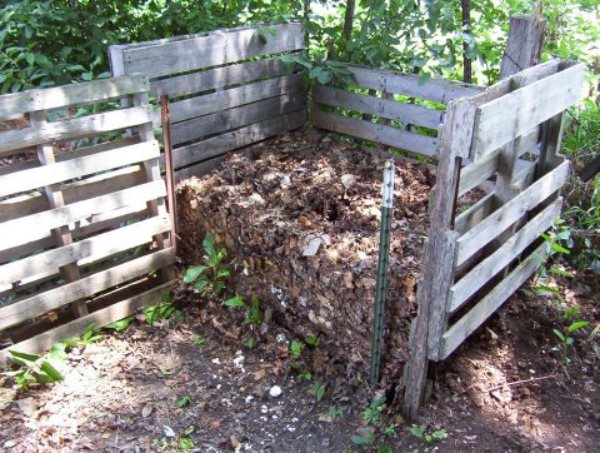 Composting box
Composting box
The recipe is as follows:
- dig a hole with a size of 1 m * 1 m, the depth should not exceed 1-1.5 m;
- collect all the leaves on the plot and brought from other places and dump them into the prepared earthen “container”;
- pour a bunch of water;
- tamper thoroughly;
- fill up with soil (soil thickness varies between 0.2-0.3 m).
In the spring, peppers, tomatoes, cabbage and other vegetables are planted on this "enriched" territory. In the fall, after harvesting, you should dig a hole and scatter cooked humus from overripe leaves throughout the plot. If there is little natural “wealth” left in the pit - good. It is covered with earth, and part of the contents remains for the next year.  Leaf compost
Leaf compost
The humus from large walnut leaves deserves special attention. They contain more organic matter than other foliage. To fertilize the soil with such humus in the future, you need to do the following:
- put the foliage in a compost heap;
- dilute 20-30 gr. nitrogen fertilizer in 10 liters of water and spray the heap with the prepared composition;
- periodically shake in the spring with a pitchfork and moisten the foliage in a compost heap.
Remember that walnut leaves decompose very “hard”. Therefore, for their speedy transformation into top dressing for the soil, it is better to add mowed grass or sawdust. 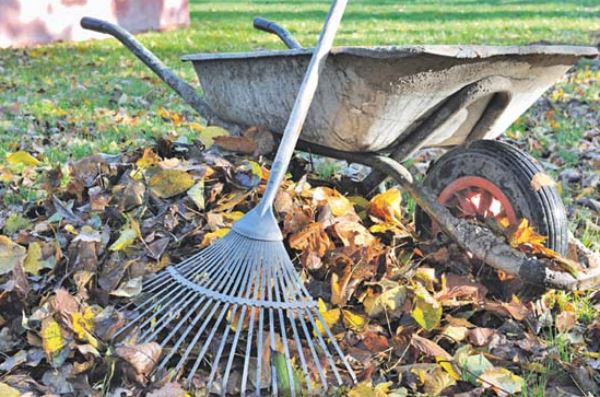 Foliage picker
Foliage picker
High-quality humus from foliage is a dark, friable mass homogeneous in color and texture without the content of whole leaves. To make humus quality, you need to adhere to one rule: the leaves should always be moist. It does not need a large amount of oxygen, as for compost, but moisture is needed. So after laying the leaves in a container or pit, they must be poured with water and periodically repeated moistening.
So, the time has come to get acquainted with the intricacies of using rotted leaves:  Leaf litter mulch
Leaf litter mulch
- In winter, a cover of deciduous mulch is useful as an upper, protective layer: from weeds, soil leaching, weathering.
- It is highly recommended not to prepare fertilizers from the foliage of fruit trees and berry bushes, as pathogens can “live” on the leaves. To extract at least some benefit from the decoration of fruiting trees, the leaves are burned, and the resulting ash is used in the garden.
- Leaf litter is used to fertilize not only vegetable crops, but also fruit trees and bushes. To do this, a square with a side of 1.2 m is dug up around the perimeter of the tree's growth. The upper soil layer (about 0.2 m) is carefully removed so as not to damage the roots of the plant. Then the leaves are folded here and 2 cups of chicken droppings are evenly added. Above, the mulch is plentifully watered with water. After a few days (2-3 days), the future humus is covered with soil. So, the trees themselves "feed". In addition, in the cold season, fallen leaves will protect the plant from frost.
- If there is no need to enrich the soil with useful substances, and the "golden" decoration interferes, you can call for help the lawn mower. She will grind the crumbling leaves, which until spring will independently “feed” the soil. Just first you need to remove the basket from the mower.
Deciduous mulch is a good fertilizer that enriches the soil and loosens it. And one more undoubted advantage: thanks to humus, insectivorous birds and hedgehogs can be “enticed” to the site, which will save them from annoying pests (for example, from a bear).


